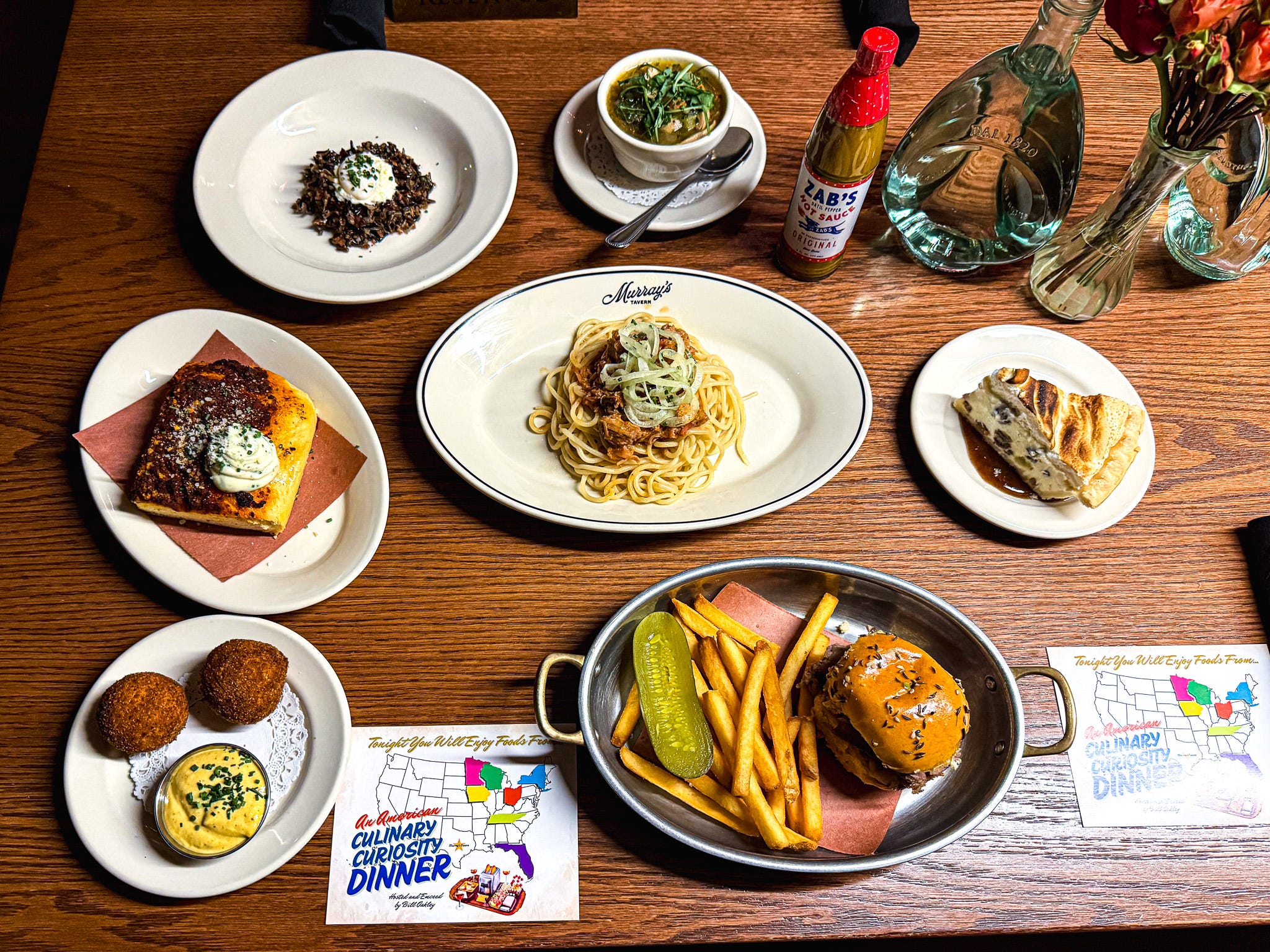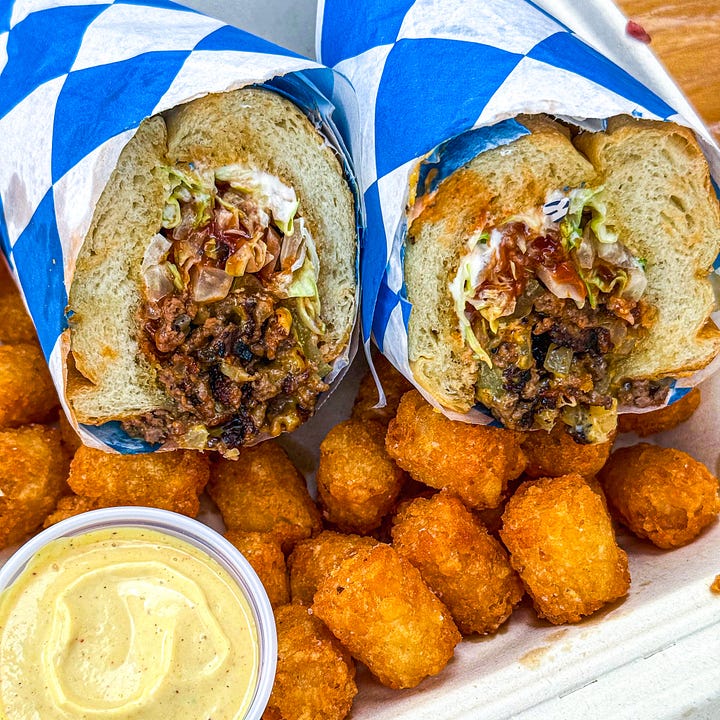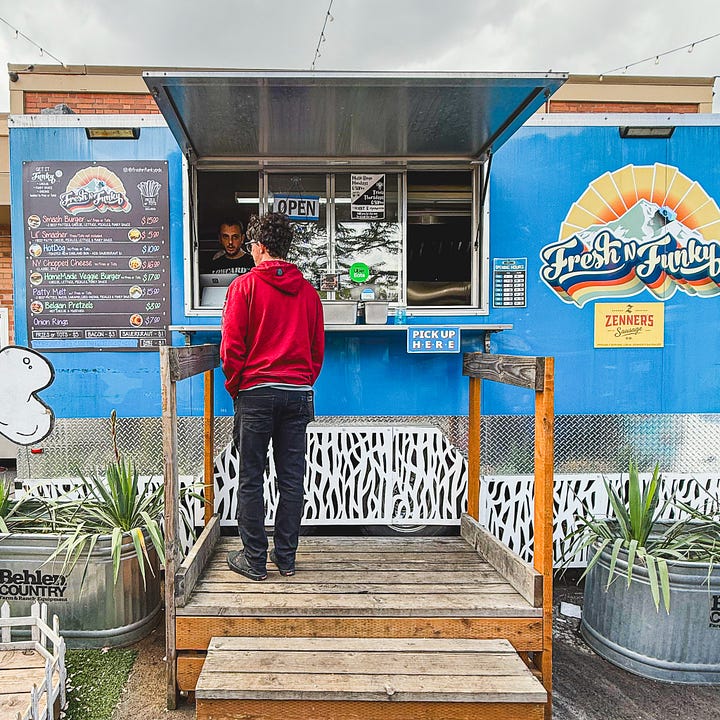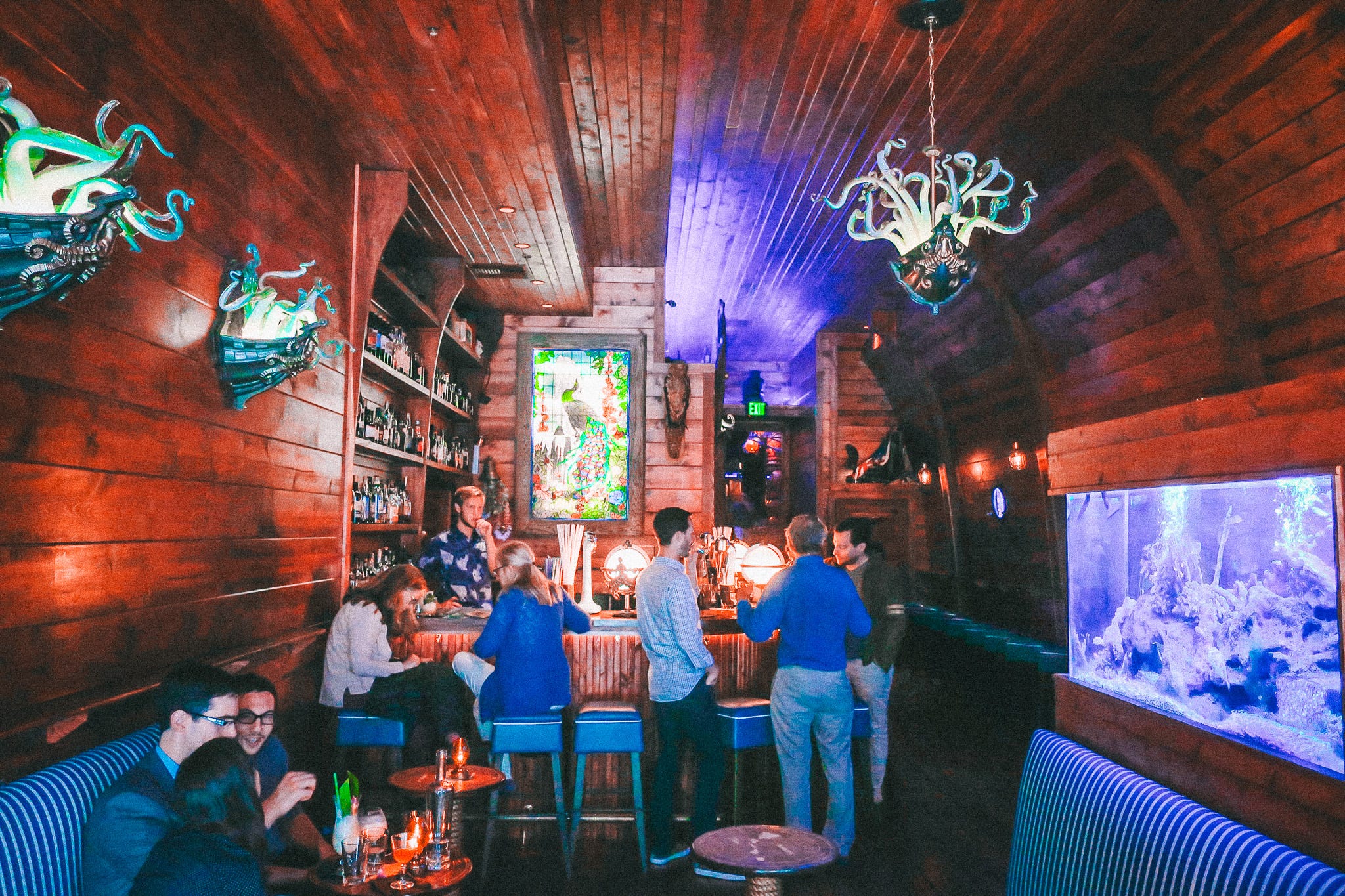Known Traveler: Bill Oakley, Comedy Writer and Food Lover
The former Simpsons showrunner on favorite regional dishes, his new dinner series, and eating adventures.
Welcome to the weekend!
While in Portland, Oregon last month, we met up with Bill Oakley, a fellow American food obsessive. Oakley, who made his name as a comedy writer on The Simpsons, Portlandia, and many other projects, recently launched his series, An American Culinary Curiosity Dinner. We caught up with him for a Known Traveler interview to talk about some favorite regional foods, Portland’s dining scene, and more.
Want more Oregon travel ideas? Download our brand-new Featured Field Guide to McMinnville & Oregon Wine Country, a three-day itinerary that features all our favorite places to eat and drink in the area. From fancy lunches at winery tasting rooms to taco carts, our guide covers the best of the region. All our Field Guides are included in a paid subscription or can be purchased individually on our website. A paid subscription also includes access to our Google map (it has more than 800 places!) plus the ability to get travel advice from us and fellow American Weekender readers via our chat.
For The Order this week, we head out for drinks in the mountain town of Asheville, North Carolina. We’ll take you to three great spots for a tipple: Little Jumbo, Sovereign Remedies, and Burial Beer’s Forestry Camp.
Finally, before we sign off for the weekend, we’ve put together a Weekend Reading list featuring some great Bay Area tropical bars, a central Ohio day trip, and an unusual Atlantic coast cocktail that has become a regional favorite.
Thanks for reading!
— Amy Cavanaugh & Kenney Marlatt

Meet Bill Oakley, Comedy Writer and Food Obsessive
PORTLAND, ORE. — When we travel, we always seek out what makes the local food scene special — you may have seen our coverage of chili dogs, lobster rolls, hot tamales, and pepperoni rolls. Bill Oakley, who made his name as a comedy writer, is similarly obsessed with regional foods — so much so that he’s launched a new dinner series, An American Culinary Curiosity Dinner, which serves a wide range of regional curiosities at events across the country. In this interview, we dig into his comedy background, his foray into fast food reviews, and the completely out-there regional pizza style he’s loving right now.
You’re best known for your comedy career, which has included producing and writing for shows like The Simpsons and Portlandia. Could you give readers a little background about that part of your career?
For many years, I wrote with partner Josh Weinstein, my best friend from high school. It was a struggle at the beginning, then we got a huge break and got hired for The Simpsons. We worked our way up the ladder to become the showrunners for seasons 7 and 8. After that, we created our own show, Mission Hill. We worked on Futurama and did some pilots, then Josh and I started doing separate things. We still do some things together occasionally. But we’re two guys with families and if you work as partners, you have to split a salary.
How did you end up in Portland?
Around that time, I had my third kid in Los Angeles — living in LA is difficult as it is, but with three kids, not only is it expensive, there’s all the traffic and driving three kids around. So we were like, we should find somewhere to live where it’ll be easier. Some friends had moved here and were loving it. We came and visited and realized it was perfect - it had good public schools and the lifestyle is more sane and cheaper. Your six-year-old could walk to the store by themselves — it was more like growing up in the ’70s when I grew up. I moved here in 2009.

Has your love of food always worked its way into your comedy?
When I was assembling the slideshow for the Austin event, I realized that I’ve been doing food jokes for a long time. On The Simpsons, I wrote “Steamed Hams,” but I did them even going back to college and high school. I found a thing for my college humor magazine that was a dining hall guide with 100 fake foods. That was in 1987.
On The Simpsons there were so many food jokes. Josh and I once were like, we have five food jokes on that page - there has to be something else. Celebrating and satirizing American food has been something that I have done since high school. It’s definitely a huge part of every project I’ve done and it’s always been an interest of mind. It’s American food, not fine dining. I got into doing it part time about seven years ago.
Was that in 2018 when you posted a video review of McDonald’s refreshed quarter pounder?
It was. I was always the kind of person who wanted to try the new McDonald’s thing the moment it came out and tell people about it. I used to tell people verbally or put it on Twitter. McDonald’s had the new quarter pounder, and I went and did a video. Then I got comments from McDonald’s and the head chef commented about it being the beginning of my career as a food blogger, and I thought, hey, that’s not a bad idea.
It’s still not my career, I’m still a comedy writer, but I spend at least half my time on this, if not more. I started on Instagram doing exclusively fast food and then it grew into more than fast food — consumer packaged goods or stuff people sent me, like local potato chips. It’s expanded way beyond fast food, it’s American everyday food.

That led to the Steamies and the Steamed Hams Society. Can you tell us about those projects?
The most famous thing I wrote for The Simpsons was the “Steamed Hams” sketch, where it’s a euphemism for hamburgers. When I started doing things, I wanted to marry my Simpsons history and food, so a lot of the things I do have “steamed” or “steam” in them.
It began with the Steamies. Those are 10 or 12 videos that are less than a minute giving awards for the best and worst things I had that year. We’re going on eight years. I do things like condiment of the year, potato chip of the year, most disappointing grocery item of the year, and most disappointing fast food. I usually have presenters, sometimes celebrities, sometimes friends of mine or Steamed Hams Society members.
The Steamed Hams Society is a club that started two years ago for people interested in this kind of thing. It’s $5 a month and is entirely on Discord. It’s basically like a bulletin board, with 20 different channels for snacks, beverages, home cooking, fast food, and grocery finds, as well as channels for things like video games or politics. It’s very active with several hundred people on there all day long talking about food and recipes they’re making or what the new Taco Bell thing is like.




Let’s talk a little about Portland’s food scene. Portland is well known for its food carts. When we were in town last month you took us to Heist, one of your favorite food cart pods. What makes the food cart scene special?
Many people say the Portland food scene is the best food scene in the country. I do, and I think that a large part of that is not only because of the excellent restaurants but because we have the food cart scene. I think it had a downturn after the pandemic, but it’s back and bigger than before. Three new pods opened in the past six months.
The reason for the origin of the food cart scene is because it’s too expensive to start a restaurant in San Francisco or Seattle, but you can move here and open a food cart. And if you handle it right, you can open a restaurant. Lardo started as a food cart, now there are different locations, including one in Las Vegas. That’s one success story, but there are many. What I love about it is that you have many choices for different foods, so not everybody has to agree on what to eat. Also, the food is unusually good - people usually think that food trucks are low rent and have pre-made sandwiches, but at the carts here, the food is better than at restaurants. There’s the fact that there’s a low barrier to entry, and there are a lot of very interesting things you would not see at a restaurant. There’s food from Guyana and Tibet at just that one pod.
You’re also known for your love of sandwiches and pointed us to the club sandwich made with chicken salad at Fuller’s Coffee Shop. Can you tell us about that?
Fuller’s also has a spin-off, Fuller’s Burger Shack, which only serves their burgers. It’s also excellent. The coffee shop has been around since 1947 and it doesn’t seem like it has changed a bit. It’s very small and everyone sits on stools. The food is regular diner food from that era, but it’s really delicious. I don’t know how they get their burger and club sandwich that good.
What are some other favorite Portland sandwiches?
So many places. Sammich is a place that has Chicago-style sandwiches. They have one called the pastrami zombie that is probably my favorite sandwich in town. There’s a place called Matt & Memere's that has New Orleans-style po boys made with Ledenheimer’s rolls they fly in. Jojo is a cart and a restaurant that’s been making incredible chicken sandwiches for years. Bunk is famous for its Cubano.
How did you get into regional food?
After my partner and I left The Simpsons, we did a show called Mission Hill, which was an animated show that was cancelled almost immediately. But it was bought and rerun on Adult Swim for years, so it built a fan base. It’s not streaming anywhere now, but for our 25th anniversary, we did a tour showing it in movie theaters all over the country. We went to cities I hadn’t been to before, like Detroit and Pittsburgh, and wherever I went, I made it into an eating adventure — what can I get here that I can’t get anywhere else?
In most cities you can get a Chicago-style hot dog, though it won’t be authentic, or Detroit-style pizza. Then there are things like Cincinnati-style chili, Ohio Valley-style pizza, and Kentucky hot browns that surprise me in that they’re not more widespread. Sometimes you can only get them within a few miles. I thought, I want to eat these things and I’ll bet other people do too. I thought I could do a pop-up at an adventurous restaurant that wants to try new things. They can fill seats on a night they’re not busy, and I can talk about the menu, make a funny slideshow, and we can all get to try the food together.
What are some dishes you’ve served at An American Culinary Curiosity Dinner series?
One of the most popular dishes has been sauerkraut balls. We’ve served both the Cincinnati and the Akron versions. They’re balls of sauerkraut with ground pork or pork sausage, chopped onions, and herbs, fried in a ball like a hushpuppy, and usually served with a remoulade dipping sauce. The Cincinnati version has cream cheese in the mix inside. Apparently, the two cities have a rivalry and each city claims to have invented it.
We’ve also done Rhode Island-style clam chowder, chicken à la Maryland, St. Louis gooey butter cake, beef on weck, Memphis barbecue spaghetti, and Iowa sour cream and raisin pie. For the Cincinnati dinner, we also did a Kentucky hot brown and Altoona-style pizza, which is America’s most infamous pizza. Whenever a photo comes out online, everyone freaks out and it gets like 10,000 replies on Twitter. It’s a Sicilian crust with tomato sauce and on top is a slice of salami, a slice of green pepper, and American cheese.
How do you select the dishes for each dinner?
I have a list of dishes that I’ve been compiling over the years. I sorted them into small bites, soups, apps, entrees, amuse bouches, and things like that. I find a restaurant or chef and send them the list and say, feel free to pick from this list or add your own. When we did the Austin dinner, the chef did three things I’d never heard of.
As you’ve traveled and worked on this dinner series, have there been any regional dishes you’ve particularly loved?
I was shockingly delighted by Ohio Valley pizza. It has cold toppings, so the cheese is put on cold, the pepperoni is put on cold. People flip out when they see this. It’s hard to say it’s pizza, it’s more like adult Lunchables, but it’s extremely good. I was also surprised by how much I enjoyed Cincinnati chili. I didn’t understand it until I visited and was squired around by someone who lives there. You don’t put it in a bowl and eat it with a spoon, you put it on spaghetti or hot dogs. It’s a topping. I’d eaten it from a can in a bowl before, but as a topping it’s great. It shouldn’t be called chili.
And I’ve really been delighted by the Polish food I’ve eaten in Syracuse and Detroit. Every Polish dish I’ve had has been amazing, like pickle soup in Detroit. It doesn’t qualify as American regional food, but every time I go to one of those places, I want more Polish food.
Where is the dinner series off to next?
We’re doing San Diego on July 15 and 16, Atlanta on July 22, Greensboro, North Carolina on August 10 and 11, and Boston on August 18. I’m hoping to line up Chicago, Milwaukee, Nashville, Los Angeles, and New York for the fall.
To get tickets and keep up on future dates, visit billoakley.com and follow his Instagram account, @thatbilloakley.
Download All Our McMinnville Recommendations
This month, we published our brand new Field Guide to McMinnville & Oregon Wine Country, which is free for paid subscribers! This 44-page dining guide includes a curated three-day itinerary with more than two dozen recommendations for breakfast, lunch, dinner, and drinks. It’s downloadable for offline reading, includes Google Maps and Instagram links, and is formatted for your phone — perfect for easy reference on your next trip. Paid subscribers can download a free copy from our website by using the code found in this month’s Weekend Getaway newsletter. Plus: As a paid subscriber, you can use the code to get any other Field Guide you’d like, free of charge!
3 Great Spots for a Drink in Asheville
ASHEVILLE, N.C. — North Carolina is filled with great cities to eat and drink — we’ve shared some favorite spots in Raleigh, Davidson, and Chapel Hill previously — and Asheville is no different.
Grab a pint at Burial Beer’s Forestry Camp, one of the coolest breweries we’ve been to. Located on a two-acre, 100-year-old camp where young men from the Civilian Conservation Corps were stationed (the CCC was a New Deal program that provided jobs for young men to work on environmental projects, such as creating the nearby Blue Ridge Parkway), it’s now a brewery, where you can have a beer among the trees outside or in the rustic taproom. Burial’s beers span a range of styles, from IPAs to lagers. Try pours like One of Us Will Have To Bend Until We Snap, a Mexican lager.
Little Jumbo is a casual cocktail spot that serves one of the best Pimm’s Cups variations we’ve had — the Foxyhot includes Pimm’s, lemon, sugar, and Angostura and cardamom bitters, and is finished with Blenheim’s ginger ale. The bar also offers live jazz and has some of the nicest bartenders (seriously, if you sign up for their mailing list, you’ll get a Christmas card every year).
Finish your night at Sovereign Remedies, a beautiful plant-bedecked bar that serves well-made classics and original drinks. They do a great job showcasing local spirits — try the Appalachian Spring Negroni with gin, local Eda Rhyne Amaro Flora, and Cocchi Americano — or classics like the freezer dirty martini, with housemade blue cheese vodka and brined olives, a nice cap to any day.
CALIFORNIA
Eight Bay Area Tropical Bars to Know: Writing for her newsletter Good Taste,
recently explored the tiki bar scene that has long captured the imagination of the Bay Area. “San Francisco is home to an epicenter of escapism: It was one of the original hotbeds of tiki, back in the day, and it has retained perhaps a higher number of those sorts of bars and their descendants than anywhere else in the U.S.” Maier stops in at many of our favorites, including Smuggler’s Cove, Pagan Idol, Tonga Room (go for the vibe if not the drinks), and one of the last Trader Vic’s.OHIO
A Day Trip to Springfield, Ohio:
and shared a dispatch from Springfield, Ohio in a recent edition of The Columbus Foodletter. “Some attribute the beginnings of Springfield’s culinary momentum to Speakeasy Ramen, a spot that’s just a few blocks from Frank Lloyd Wright's Westcott House. This “5 star dive bar” that opened in 2019 has drawn fans from far and wide seeking out its flavorful takes on Japanese cuisine paired with hints of Southern cooking, with both influences reflecting the background and training of the restaurant’s founders.” Meanwhile, I’m putting Casa Centro Modern Mexican on our to-do list. Any place making a great mole is worth a stop in my book.DELAWARE
Crushing It on the Delaware Shore: I’ve never had an Orange Crush but, unsurprisingly,
has made himself an expert. “The Orange Crush is an easygoing beach cocktail made of orange-flavored vodka, triple sec, lemon-lime soda, and freshly squeezed orange juice, served in a pint glass over ice,” Simonson writes in The Mix. “It first emerged in the 1990s. And both Maryland and Delaware claim it as their own.” Simonson hits up The Starboard, Crooked Hammock Brewery, and more to explore the regional favorite. “While Crushes have been big business for some time, lately they have exploded in popularity. You see them in every summer drinker’s hand, the Delaware coast’s version of Italy’s Aperol Spritz.” Delaware’s Aperol Spritz? I’m sold.— Compiled by Kenney Marlatt
Want more? Chat with us on Substack, download our Field Guides, check out our archives, or follow us on Instagram @americanweekender. We’ll be back next week.
















This was great, makes me want some Albany-style “Steamed Hams” 😉
Thanks so much for the shout-out! The SF tiki bar roundup was super fun to report and write — I’m glad you enjoyed it!